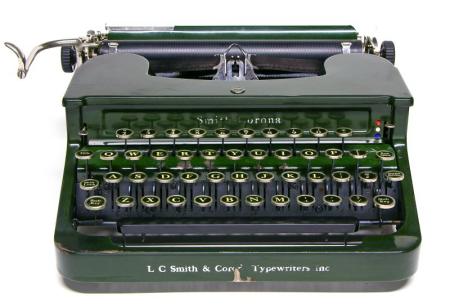
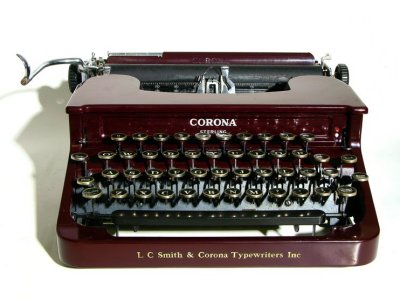 Sometimes referred to among collectors as the "Flattop", Smith-Corona made its first multi-model product line expansion in 1931 with this design. It was available in burgundy, green, or black. Very early models such as the one pictured above bore only the name "Smith-Corona"; the Sterling name didn't appear until 1933 or -4. The look appears to borrow heavily from the popular Royal Portable of the late '20s, but may have been an attempt to mimic the style of L.C. Smith's office machines. Sometimes referred to among collectors as the "Flattop", Smith-Corona made its first multi-model product line expansion in 1931 with this design. It was available in burgundy, green, or black. Very early models such as the one pictured above bore only the name "Smith-Corona"; the Sterling name didn't appear until 1933 or -4. The look appears to borrow heavily from the popular Royal Portable of the late '20s, but may have been an attempt to mimic the style of L.C. Smith's office machines.
|

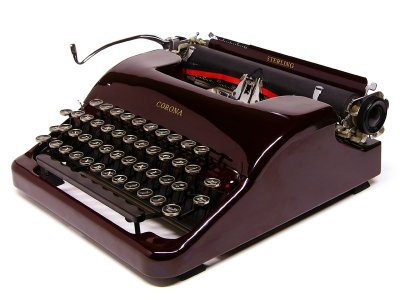 In 1938, Smith-Corona introduced the ultra-modern Speedline body. In addition to burgundy and black, these can sometimes be found also in tan. Some collectors consider this to be one of the most beautiful typewriters ever produced. In 1938, Smith-Corona introduced the ultra-modern Speedline body. In addition to burgundy and black, these can sometimes be found also in tan. Some collectors consider this to be one of the most beautiful typewriters ever produced.
1948 was the last official year for the Speedline, but Speedline-bodied typewriters appeared sporadically well into the early 1950s, particulary as rebadged catalog brands.
|

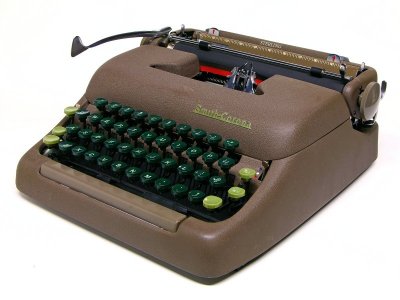 In late 1949, a radical product line redesign was revealed, internally called the Super-5. The body is beefier, with the tab sets enclosed and protected from dust, and the familiar circular bakelite keys replaced with "teardrop" shaped resin keys that fit the user's fingers better. A "Page-Gage" was also introduced. This was a marked drum fitted to the end of the platen cylinder that told the user how many inches remained until the bottom of the page. Handy! In late 1949, a radical product line redesign was revealed, internally called the Super-5. The body is beefier, with the tab sets enclosed and protected from dust, and the familiar circular bakelite keys replaced with "teardrop" shaped resin keys that fit the user's fingers better. A "Page-Gage" was also introduced. This was a marked drum fitted to the end of the platen cylinder that told the user how many inches remained until the bottom of the page. Handy!
Previously available only on the Silent and Standard models, the Sterling now gets a paper-bail, too.
|

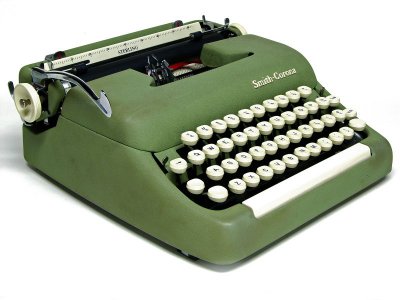 This 1959 Sterling is a minor variation of the 1950 above. Around 1957 or '58, Smith-Corona began offering their line in different colors with white keys. They included Sapphire (grey), Coral (pink), Desert Sand (tan) and Alpine Blue. This one is Seafoam Green. This 1959 Sterling is a minor variation of the 1950 above. Around 1957 or '58, Smith-Corona began offering their line in different colors with white keys. They included Sapphire (grey), Coral (pink), Desert Sand (tan) and Alpine Blue. This one is Seafoam Green.
With a few exceptions (see below), the Super-5 was discontinued in 1959. |

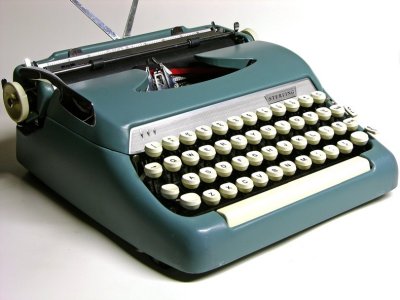 Another Super-5 bodied Sterling, but this one is from 1963, four years after the Super-5 body was supposedly discontinued. However, the overall styling that was to define the new generation of Smith-Corona products is clearly evident. Note that mechanically this "Sterling" is actually the late Super-Silent reincarnated. Another Super-5 bodied Sterling, but this one is from 1963, four years after the Super-5 body was supposedly discontinued. However, the overall styling that was to define the new generation of Smith-Corona products is clearly evident. Note that mechanically this "Sterling" is actually the late Super-Silent reincarnated.
|

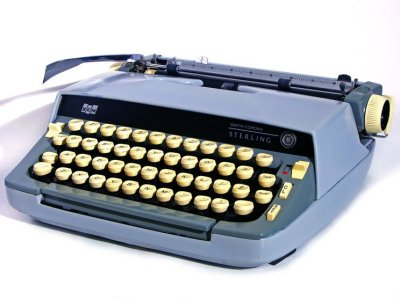 Here is a Sterling from the late '60s or early '70s. Smith-Corona entered the age of the modern office in 1959 with a redesigned machine called the Galaxie and a new name and emblem: Smith-Corona Marchant (or SCM). Soon, the entire product line adopted the Galaxie's boxy, no-nonsense look. As far as I can tell, this was the end of the Sterling. Here is a Sterling from the late '60s or early '70s. Smith-Corona entered the age of the modern office in 1959 with a redesigned machine called the Galaxie and a new name and emblem: Smith-Corona Marchant (or SCM). Soon, the entire product line adopted the Galaxie's boxy, no-nonsense look. As far as I can tell, this was the end of the Sterling.
|
![]()